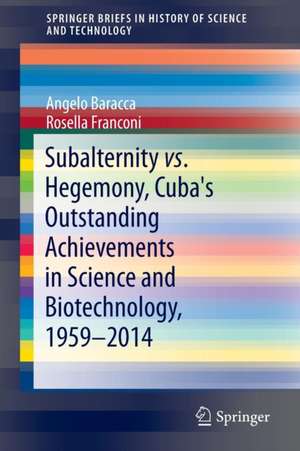Subalternity vs. Hegemony, Cuba's Outstanding Achievements in Science and Biotechnology, 1959-2014: SpringerBriefs in History of Science and Technology
Autor Angelo Baracca, Rosella Franconien Limba Engleză Paperback – 21 iul 2016
In the early 1990s the sudden collapse of the Soviet Union and the socialist market created an unprecedented challenge. Yet Cuba’s scientific system substantially resiled, despite unavoidable setbacks. This crisis was faced by confirming and reinforcing government support for biotechnology, with the result that today Cuba excels at a global level in the typical capital-intensive field of biotechnology.
While this book is especially devoted to historians of science and technology and to biotechnologists, it is of interest to the general public.
Din seria SpringerBriefs in History of Science and Technology
- 8%
 Preț: 387.77 lei
Preț: 387.77 lei -
 Preț: 377.18 lei
Preț: 377.18 lei -
 Preț: 443.75 lei
Preț: 443.75 lei -
 Preț: 377.35 lei
Preț: 377.35 lei -
 Preț: 377.35 lei
Preț: 377.35 lei -
 Preț: 378.34 lei
Preț: 378.34 lei -
 Preț: 379.09 lei
Preț: 379.09 lei -
 Preț: 378.54 lei
Preț: 378.54 lei -
 Preț: 378.34 lei
Preț: 378.34 lei -
 Preț: 448.21 lei
Preț: 448.21 lei -
 Preț: 377.35 lei
Preț: 377.35 lei -
 Preț: 408.66 lei
Preț: 408.66 lei -
 Preț: 478.33 lei
Preț: 478.33 lei - 20%
 Preț: 296.67 lei
Preț: 296.67 lei -
 Preț: 411.16 lei
Preț: 411.16 lei -
 Preț: 374.30 lei
Preț: 374.30 lei -
 Preț: 379.09 lei
Preț: 379.09 lei -
 Preț: 489.30 lei
Preț: 489.30 lei -
 Preț: 378.54 lei
Preț: 378.54 lei -
 Preț: 476.57 lei
Preț: 476.57 lei -
 Preț: 378.92 lei
Preț: 378.92 lei - 15%
 Preț: 461.87 lei
Preț: 461.87 lei -
 Preț: 442.83 lei
Preț: 442.83 lei -
 Preț: 446.08 lei
Preț: 446.08 lei -
 Preț: 379.48 lei
Preț: 379.48 lei -
 Preț: 379.86 lei
Preț: 379.86 lei -
 Preț: 344.53 lei
Preț: 344.53 lei -
 Preț: 378.92 lei
Preț: 378.92 lei -
 Preț: 376.04 lei
Preț: 376.04 lei -
 Preț: 347.41 lei
Preț: 347.41 lei -
 Preț: 324.70 lei
Preț: 324.70 lei -
 Preț: 377.35 lei
Preț: 377.35 lei -
 Preț: 444.35 lei
Preț: 444.35 lei
Preț: 377.73 lei
Nou
Puncte Express: 567
Preț estimativ în valută:
72.29€ • 74.58$ • 61.18£
72.29€ • 74.58$ • 61.18£
Carte tipărită la comandă
Livrare economică 05-19 martie
Preluare comenzi: 021 569.72.76
Specificații
ISBN-13: 9783319406084
ISBN-10: 3319406086
Pagini: 74
Ilustrații: XII, 103 p.
Dimensiuni: 155 x 235 x 6 mm
Greutate: 0.17 kg
Ediția:1st ed. 2016
Editura: Springer International Publishing
Colecția Springer
Seria SpringerBriefs in History of Science and Technology
Locul publicării:Cham, Switzerland
ISBN-10: 3319406086
Pagini: 74
Ilustrații: XII, 103 p.
Dimensiuni: 155 x 235 x 6 mm
Greutate: 0.17 kg
Ediția:1st ed. 2016
Editura: Springer International Publishing
Colecția Springer
Seria SpringerBriefs in History of Science and Technology
Locul publicării:Cham, Switzerland
Cuprins
Chapter 1. Introduction. Cuba’s exceptional scientific development.- Chapter 2. Meeting subalternity, a constant challenge in Cuban history.- Chapter 3. Addressing the challenge of scientific development: the first steep steps of a long path.- Chapter 4. Reaching a critical mass and laying the foundations of an advanced scientific system.- Chapter 5. The decisive leap in the 1980s: the attainment of Cuba’s scientific autonomy.- Chapter 6. Decisive results … and new challenges.- Chapter 7. Comparative considerations and Conclusions.
Recenzii
“Subalternity vs. Hegemony is a slim volume, part of the SpringerBriefs series, which aims to provide rapid publication of concise introductions to emerging research. … Baracca and Franconi have raised a variety of intriguing questions about the relationship between scientific and economic development, and this volume will be attractive to those looking for a concise introduction to the educational reforms and scientific institutions of postrevolutionary Cuba.” (Megan Raby, Isis, Vol. 108 (3), September, 2017)
Notă biografică
Angelo Baracca has been a Professor since 1968, and an Associate Professor of Physics from 1980 at the University of Firenze. Has taught courses in: Statistical Mechanics, Elementary Particles, History of Physics, Physics for Pharmacy, and Biological Sciences. His main interests and activities cover: nuclear technology, both military and civil, its historical development and present status; science and industrial revolution, the 20th century revolution in physics. For 20 years he has collaborated with the Faculty of Physics of the University of Havana, Cuba, and has developed a comprehensive history of the development of Physics and Biotechnology in Cuba.
Rosella Franconi is a senior scientist at the Laboratory of Biomedical Technologies at ENEA, Casaccia Research Centre, Rome (since 1989). Also a ‘Contract Professor’ in different Universities (‘Sapienza’, Rome: Applied Biology; ‘Tuscia’, Viterbo: Pharmaceutical Biotechnologies; ‘Tor Vergata’ Rome: Plant Biotechnologies for the Environment and Human Health; Siena: Scientific Communication on Plant Biotechnologies). She is a Member of various scientific societies and an author of papers in international journals, book chapters and patents. Present research field: novel biopharmaceuticals (infectious agents, cancer, rare diseases).
Rosella Franconi is a senior scientist at the Laboratory of Biomedical Technologies at ENEA, Casaccia Research Centre, Rome (since 1989). Also a ‘Contract Professor’ in different Universities (‘Sapienza’, Rome: Applied Biology; ‘Tuscia’, Viterbo: Pharmaceutical Biotechnologies; ‘Tor Vergata’ Rome: Plant Biotechnologies for the Environment and Human Health; Siena: Scientific Communication on Plant Biotechnologies). She is a Member of various scientific societies and an author of papers in international journals, book chapters and patents. Present research field: novel biopharmaceuticals (infectious agents, cancer, rare diseases).
Caracteristici
Examines an example of government support for science as a strategic choice Introduces an original (new) perspective on Cuba that traces Cuban scientists’ achievements through the decades after the 1959 revolution Revisits Cuba's choice to develop an advanced healthcare and scientific system Introduces new aspects of the problem of development/underdevelopment Includes supplementary material: sn.pub/extras










